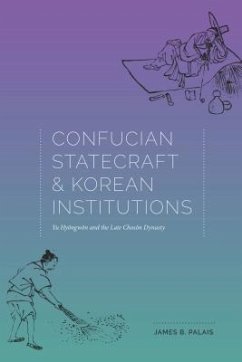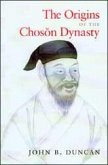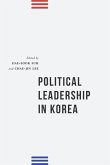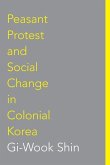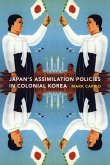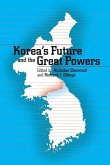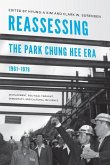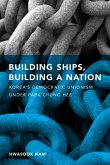- Broschiertes Buch
- Merkliste
- Auf die Merkliste
- Bewerten Bewerten
- Teilen
- Produkt teilen
- Produkterinnerung
- Produkterinnerung
James B. Palais was professor of history at the University of Washington and the author of Policy and Politics in Traditional Korea.
Andere Kunden interessierten sich auch für
![The Origins of the Choson Dynasty The Origins of the Choson Dynasty]() John B DuncanThe Origins of the Choson Dynasty42,99 €
John B DuncanThe Origins of the Choson Dynasty42,99 €![Political Leadership in Korea Political Leadership in Korea]() Political Leadership in Korea42,99 €
Political Leadership in Korea42,99 €![Peasant Protest and Social Change in Colonial Korea Peasant Protest and Social Change in Colonial Korea]() Gi-Wook ShinPeasant Protest and Social Change in Colonial Korea42,99 €
Gi-Wook ShinPeasant Protest and Social Change in Colonial Korea42,99 €![Japanese Assimilation Policies in Colonial Korea, 1910-1945 Japanese Assimilation Policies in Colonial Korea, 1910-1945]() Mark E CaprioJapanese Assimilation Policies in Colonial Korea, 1910-194542,99 €
Mark E CaprioJapanese Assimilation Policies in Colonial Korea, 1910-194542,99 €![Korea's Future and the Great Powers Korea's Future and the Great Powers]() Richard EllingsKorea's Future and the Great Powers34,99 €
Richard EllingsKorea's Future and the Great Powers34,99 €![Reassessing the Park Chung Hee Era, 1961-1979 Reassessing the Park Chung Hee Era, 1961-1979]() Reassessing the Park Chung Hee Era, 1961-197954,99 €
Reassessing the Park Chung Hee Era, 1961-197954,99 €![Building Ships, Building a Nation Building Ships, Building a Nation]() Hwasook B NamBuilding Ships, Building a Nation42,99 €
Hwasook B NamBuilding Ships, Building a Nation42,99 €-
-
-
James B. Palais was professor of history at the University of Washington and the author of Policy and Politics in Traditional Korea.
Hinweis: Dieser Artikel kann nur an eine deutsche Lieferadresse ausgeliefert werden.
Hinweis: Dieser Artikel kann nur an eine deutsche Lieferadresse ausgeliefert werden.
Produktdetails
- Produktdetails
- Verlag: University of Washington Press
- Seitenzahl: 1288
- Erscheinungstermin: 1. Mai 2014
- Englisch
- Abmessung: 242mm x 153mm x 54mm
- Gewicht: 1583g
- ISBN-13: 9780295993782
- ISBN-10: 0295993782
- Artikelnr.: 40028430
- Herstellerkennzeichnung
- Libri GmbH
- Europaallee 1
- 36244 Bad Hersfeld
- gpsr@libri.de
- Verlag: University of Washington Press
- Seitenzahl: 1288
- Erscheinungstermin: 1. Mai 2014
- Englisch
- Abmessung: 242mm x 153mm x 54mm
- Gewicht: 1583g
- ISBN-13: 9780295993782
- ISBN-10: 0295993782
- Artikelnr.: 40028430
- Herstellerkennzeichnung
- Libri GmbH
- Europaallee 1
- 36244 Bad Hersfeld
- gpsr@libri.de
James B. Palais was professor of history at the University of Washington and the author of Policy and Politics in Traditional Korea.
Acknowledgments
Introduction
PART 1: THE EARLY CHOSON DYNASTY, 1392-1650
Confucian Statecraft in the Founding of Choson
The Disintegration of the Early Choson System to 1592
Post-Imjin Developments in Military Defense and the Economy
PART 2: SOCIAL REFORM: YANGBAN AND SLAVES
Introduction
Remolding the Ruling Class through Education and Schools
New Schools: Conservative Restraints on Radicalism
Slavery: The Slow Path to Abolition
Conclusion
PART 3: LAND REFORM
Introduction
Land Reform: Compromises with the Well-Field Model
Redistributing Wealth through Land Reform
Late Choson Land Reform Proposals
Conclusion
PART 4: MILITARY REFORM
Introduction
The Royal Division Model: Rotating Duty Soldiers and Support Taxpayers
The Debate over the Military Training Agency, 1651-82
The Search for Alternative Modes of Military Finance
Military Reorganization, Weapons, and Walls
The Military Service System, 1682-1870
Conclusion
PART 5: REFORM OF GOVERNMENT ORGANIZATION
Introduction
The King and His Court
Reforming the Central Bureaucracy
Personnel Policy
Provincial and Local Administration
The Community Compact System (Hyangyak)
Yu Hyongwon's Community Compact Regulations
Conclusion
PART 6: FINANCIAL REFORM AND THE ECONOMY
Introduction
Tribute and the Taedong Reform
The Taedong Model for Official Salaries and Expenses
Copper Cash and the Monetary System
Yu Hyongwon's Analysis of Currency
The Cycle of Inflation and Deflation
Cash and Economic Change after 1731
Conclusion
Epilogue: The Complexities of Korean Confucian Statecraft
Notes
Glossary
List of Kings of the Choson Dynasty
List of Names
Bibliography
Index
Introduction
PART 1: THE EARLY CHOSON DYNASTY, 1392-1650
Confucian Statecraft in the Founding of Choson
The Disintegration of the Early Choson System to 1592
Post-Imjin Developments in Military Defense and the Economy
PART 2: SOCIAL REFORM: YANGBAN AND SLAVES
Introduction
Remolding the Ruling Class through Education and Schools
New Schools: Conservative Restraints on Radicalism
Slavery: The Slow Path to Abolition
Conclusion
PART 3: LAND REFORM
Introduction
Land Reform: Compromises with the Well-Field Model
Redistributing Wealth through Land Reform
Late Choson Land Reform Proposals
Conclusion
PART 4: MILITARY REFORM
Introduction
The Royal Division Model: Rotating Duty Soldiers and Support Taxpayers
The Debate over the Military Training Agency, 1651-82
The Search for Alternative Modes of Military Finance
Military Reorganization, Weapons, and Walls
The Military Service System, 1682-1870
Conclusion
PART 5: REFORM OF GOVERNMENT ORGANIZATION
Introduction
The King and His Court
Reforming the Central Bureaucracy
Personnel Policy
Provincial and Local Administration
The Community Compact System (Hyangyak)
Yu Hyongwon's Community Compact Regulations
Conclusion
PART 6: FINANCIAL REFORM AND THE ECONOMY
Introduction
Tribute and the Taedong Reform
The Taedong Model for Official Salaries and Expenses
Copper Cash and the Monetary System
Yu Hyongwon's Analysis of Currency
The Cycle of Inflation and Deflation
Cash and Economic Change after 1731
Conclusion
Epilogue: The Complexities of Korean Confucian Statecraft
Notes
Glossary
List of Kings of the Choson Dynasty
List of Names
Bibliography
Index
Acknowledgments
Introduction
PART 1: THE EARLY CHOSON DYNASTY, 1392-1650
Confucian Statecraft in the Founding of Choson
The Disintegration of the Early Choson System to 1592
Post-Imjin Developments in Military Defense and the Economy
PART 2: SOCIAL REFORM: YANGBAN AND SLAVES
Introduction
Remolding the Ruling Class through Education and Schools
New Schools: Conservative Restraints on Radicalism
Slavery: The Slow Path to Abolition
Conclusion
PART 3: LAND REFORM
Introduction
Land Reform: Compromises with the Well-Field Model
Redistributing Wealth through Land Reform
Late Choson Land Reform Proposals
Conclusion
PART 4: MILITARY REFORM
Introduction
The Royal Division Model: Rotating Duty Soldiers and Support Taxpayers
The Debate over the Military Training Agency, 1651-82
The Search for Alternative Modes of Military Finance
Military Reorganization, Weapons, and Walls
The Military Service System, 1682-1870
Conclusion
PART 5: REFORM OF GOVERNMENT ORGANIZATION
Introduction
The King and His Court
Reforming the Central Bureaucracy
Personnel Policy
Provincial and Local Administration
The Community Compact System (Hyangyak)
Yu Hyongwon's Community Compact Regulations
Conclusion
PART 6: FINANCIAL REFORM AND THE ECONOMY
Introduction
Tribute and the Taedong Reform
The Taedong Model for Official Salaries and Expenses
Copper Cash and the Monetary System
Yu Hyongwon's Analysis of Currency
The Cycle of Inflation and Deflation
Cash and Economic Change after 1731
Conclusion
Epilogue: The Complexities of Korean Confucian Statecraft
Notes
Glossary
List of Kings of the Choson Dynasty
List of Names
Bibliography
Index
Introduction
PART 1: THE EARLY CHOSON DYNASTY, 1392-1650
Confucian Statecraft in the Founding of Choson
The Disintegration of the Early Choson System to 1592
Post-Imjin Developments in Military Defense and the Economy
PART 2: SOCIAL REFORM: YANGBAN AND SLAVES
Introduction
Remolding the Ruling Class through Education and Schools
New Schools: Conservative Restraints on Radicalism
Slavery: The Slow Path to Abolition
Conclusion
PART 3: LAND REFORM
Introduction
Land Reform: Compromises with the Well-Field Model
Redistributing Wealth through Land Reform
Late Choson Land Reform Proposals
Conclusion
PART 4: MILITARY REFORM
Introduction
The Royal Division Model: Rotating Duty Soldiers and Support Taxpayers
The Debate over the Military Training Agency, 1651-82
The Search for Alternative Modes of Military Finance
Military Reorganization, Weapons, and Walls
The Military Service System, 1682-1870
Conclusion
PART 5: REFORM OF GOVERNMENT ORGANIZATION
Introduction
The King and His Court
Reforming the Central Bureaucracy
Personnel Policy
Provincial and Local Administration
The Community Compact System (Hyangyak)
Yu Hyongwon's Community Compact Regulations
Conclusion
PART 6: FINANCIAL REFORM AND THE ECONOMY
Introduction
Tribute and the Taedong Reform
The Taedong Model for Official Salaries and Expenses
Copper Cash and the Monetary System
Yu Hyongwon's Analysis of Currency
The Cycle of Inflation and Deflation
Cash and Economic Change after 1731
Conclusion
Epilogue: The Complexities of Korean Confucian Statecraft
Notes
Glossary
List of Kings of the Choson Dynasty
List of Names
Bibliography
Index

